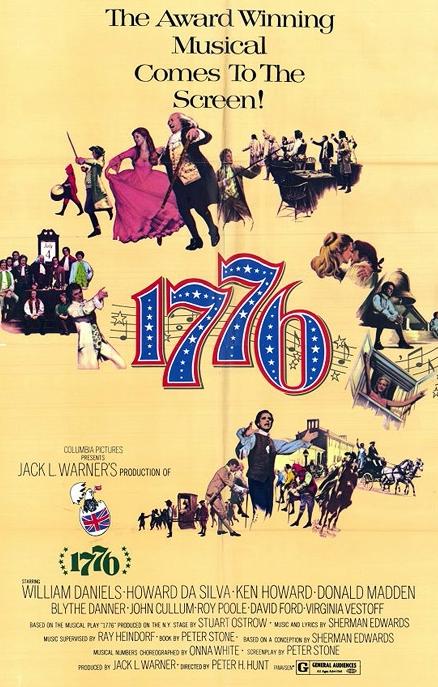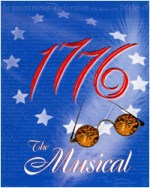1776
Musical (1969)
Inspiration historique: Révolution américaine et rédaction constitution

The story is based on the events surrounding the signing of the Declaration of Independence. It focuses on, and partly fictionalizes, the efforts of John Adams to persuade his colleagues to vote for American independence and to sign the document.
In 1926, Rodgers and Hart had written the only previous musical about the American revolution, called Dearest Enemy.
Sherman Edwards, a singer of pop-songs with several top ten hits in the late fifties and early sixties, spent several years developing lyrics and libretto for a musical based on the signing of the Declaration of Independence. Edwards recounted that, "I wanted to show [the founding fathers] at their outermost limits. These men were the cream of their colonies... They disagreed and fought with each other. But they understood commitment, and though they fought, they fought affirmatively."
Producer Stuart Ostrow recommended that librettist Peter Stone collaborate with Edwards on the book of the musical. Stone recalled, "The minute you heard ["Sit Down, John"], you knew what the whole show was.... You knew immediately that John Adams and the others were not going to be treated as gods, or cardboard characters, chopping down cherry trees and flying kites with strings and keys on them. It had this very affectionate familiarity; it wasn't reverential." Adams, the outspoken delegate from Massachusetts, was chosen as the central character, and his quest to persuade all thirteen colonies to vote for independence became the central conflict. Stone confined nearly all of the action to Independence Hall and the debate among the delegates, featuring only two female characters, Abigail Adams and Martha Jefferson, in the entire musical.
After tryouts in New Haven and Washington, the show opened on Broadway at the 46th Street Theatre on March 16, 1969. Peter Hunt, previously known as a lighting designer, directed. Earning warm reviews, it ran for 1,217 performances. The production was nominated for five Tony Awards and won three, including the Tony Award for Best Musical. The musical was made into a film of the same name in 1972 and was revived on Broadway in 1997.
Ce musical s'intéresse aux luttes du Congrès Continental américain se déclarer indépendants de l'Angleterre et des lois oppressives du Roi George III. Les principaux meneurs de l'idée d'indépendance sont l"odieux et détesté" John Adams, Benjamin Franklin et Thomas Jefferson qui est désigné pour écrire la Déclaration d'Indépendance. Les forces qui s'y opposent, incluent les représentants des états esclavagistes, menés par Edward Rutledge qui refuse de s'engager à signer la Déclaration si elle prévoit explicitement une libèration des esclaves; et les conservateurs riches, menés par John Dickinson, qui ne veulent pas mettre leurs richesses en danger en défiant la mère patrie, l'Angleterre. Chaque colonie a envoyé trois représentants - et donc une majorité simple de deux représentants décidera du vote d'une colonie donnée - mais le vote réel pour indépendance doit être unanime pour se montrer unis face à l'Angleterre; autrement, le nouveau pays devant affronter des lurttes internes en même temps que le combat contre l'Angleterre, ne pourra que disparaître.
Afficher le synopsis détaillé
It is another sultry day in Philadelphia. Washington's army needs money, the flies are murder and John Adams keeps on about Independence. Members of the Continental Congress are sick of his words and Benjamin Franklin knows it. He persuades John to let someone else, perhaps from the South, to introduce the measure
Franklin has asked the gullible Richard Henry lee to stop by and permits him to think of such a solution. Lee is off to his state legislature to be so directed. Lee finally returns and wastes no time in bringing the motion to the floor. Opponents quickly move to have the measure postponed. Adams, for once, convinces the Congress that the matter should at least be discussed. The narrow vote is against defeat. The opposition counters with a motion that any vote in independence be unanimous and this motion is carried. It is decided that the best way to present the measure would be in the form of a declaration. But who will write it? Everyone in the committee tries to avoid being landed with the job but in the end it is agreed that Thomas Jefferson should be the one to draw up such a declaration. He, however, wants to spend some time with his young wife, Martha, from whom he has been away too long.
Adam arranges for her to be brought to Philadelphia and work on the document proceeds vigorously.
The Independence Committee is called to investigate the problems of womanising, drinking and the "French disease" in Washington's army and to settle other important and grim matters the General keeps bringing before Congress.
In their absence the conservatives have their day by pleading the case against independence and pledge loyalty to the most powerful crown in the world. However, when Adams, Franklin and the others return from the front, they are inspired with the will to win! This spirit proves infectious and it paves the way for a debate on the Declaration. There are changes and compromises, but nothing of serious consequence. That is, until Edward Rutledge threatens to lead the South against the measure of freeing the slaves is permitted to remain in the proposal. Adam puts up a heated argument but Franklin, the founder of America's first anti-slavery society, suggests they agree to the deletion in order to give birth to the nation. A game of carefully waged politics wins the last few remaining pockets of resistance. American liberty is born as each member of the committee signs his name to the Declaration of Independence.
Originally, there was no intermission. When the show opened in London, an intermission was added after "Momma, Look Sharp." An intermission was soon added to the still-running Broadway and national tour productions and has been used in most subsequent productions.
The entire New Brunswick sequence, covering three scenes and featuring several songs, was cut prior to Broadway. "Momma, Look Sharp" is the one song from the sequence that was retained, repositioned in the show and given to a different character. Otherwise, a pre-rehearsal script is extremely close to the final version, though it's missing "The Egg," added out of town (and apparently inspired, in a reversal of what might be expected, by the show's logo).
1 1776 s'intéresse à un événement historique important: Révolution américaine et rédaction constitution.
Overture
"Sit Down, John" – Adams and Congress
"Piddle, Twiddle and Resolve"/"Till Then" – Adams
"Till Then" – John and Abigail Adams
"The Lees of Old Virginia" – Lee, Franklin and Adams
"But, Mr. Adams" – Adams, Franklin, Jefferson, Sherman and Livingston
"Yours, Yours, Yours" – John and Abigail Adams
"He Plays the Violin" – Martha Jefferson, Franklin and Adams
"Cool, Cool, Considerate Men" – Dickinson and The Conservatives
"Mama Look Sharp" – Courier, McNair and Leather Apron
"The Egg" – Franklin, Adams and Jefferson
"Molasses to Rum" – Rutledge
"Compliments" – Abigail Adams
"Is Anybody There?" – Adams
Finale
John Hancock: President of the 2 nd Continental Congress. First to sign the Declaration of Independence with a very large signature so that "fat [King] George.. .can read it without his glasses!"
Dr. Josiah Bartlett: A New Hampshire delegate. Sides in favor of independence.
John Adams: A Massachusetts delegate. A man found to be "obnoxious and disliked"1 by many members of Congress, he is the leading advocate for separation from England.
Stephen Hopkins: A Rhode Island Delegate. He would prefer to be found at all times with a tankard of rum in his hand.
Roger Sherman: A Connecticut delegate, he sides in favor of independence and is a member of the committee charged with writing the Declaration.
Lewis Morris: A New York delegate, he abstains.. ."courteously" on every vote, even from the original vote on accepting the Declaration.
Robert Livingston: A New York delegate, he is a member of the committee formed to write the Declaration.
Reverend John Witherspoon: Delegate of New Jersey. Witherspoon argues for, and wins, the inclusion of a reference to the Supreme Being in the Declaration.
Benjamin Franklin: A Pennsylvania delegate, who, along with John Adams, leads those in favor of breaking away from England. Very urbane, cool-headed.. .a skilled negotiator.
John Dickinson: A Pennsylvania delegate, he advocates a reconciliation with England and King George III. Fierce opponent of Adams.
James Wilson: A Pennsylvania delegate, he casts the final vote to approve the independence declaration. He does so, not out of any strong belief in independence, but because he wishes to remain anonymous, one of the many, instead of forever being known as "the man who prevented American independence."
Caesar Rodney: A Delaware delegate. Has skin cancer and leaves what is, probably, his death bed to vote. Favors independence.
Colonel Thomas McKean: Delaware delegate. Pronounced Scots accent. Favors independence.
George Read: Delaware delegate who sides with Dickinson.
Samuel Chase: A Maryland delegate. Prefers eating to debating. Changes his allegiances during the run up to the final vote on accepting the declaration.
Richard Henry Lee: A Virginia delegate, who returns home to secure from the Virginia state legislature a resolution proclaiming independence from England.
Thomas Jefferson: A Virginia delegate. Writes the initial draft of the Declaration of Independence. Eventually, approves all changes in the document that are offered by the delegates.
Edward Rutledge: Delegate from South Carolina. Youngest member of Congress, he leads the opposition to Jefferson's declaration, because it advocates the abolition of slavery.
Joseph Hewes: North Carolina delegate. Sides with Rutledge on the slavery issue.
Dr. Lyman Hall: Georgia delegate. Independent thinker, who weighs all issues before giving his support to either side.
Charles Thomson: The secretary of the Congress.
Andrew McNair: Custodian and bell-ringer.
Courier: Brings dispatches from General Washington.
Abigail Adams: Wife of John Adams. Not present in Philadelphia, but appears to her husband through letters and fantasies.
Martha Jefferson: Wife of Thomas Jefferson. Summoned to Philadelphia by Ben Franklin when Jefferson develops writer's block.
Aucun dossier informatif complémentaire concernant 1776
Aucun dossier informatif complémentaire concernant 1776
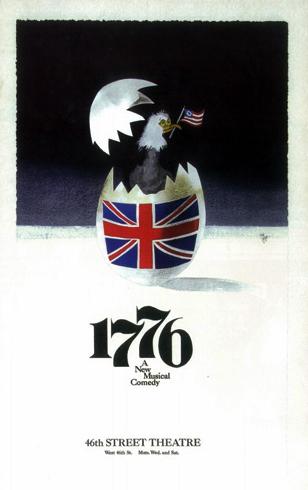
Version 1
1776 (1969-03-Richard Rodger's Theatre)
Type de série: Original BroadwayThéâtre: Richard Rodgers Theatre (Broadway - Etats-Unis) Durée : Nombre : 5 previews - 1217 représentationsPremière Preview : Inconnu
Première: 16 March 1969
Dernière: 13 February 1972Mise en scène : Peter Hunt • Chorégraphie : Onna White • Producteur : Star(s) : Commentaires longs: Le spectacle s'est joué :
Richard Rodger's Theatre (alors le 46th Street Theatre) du 16/3/1969 au 27/12/1970 puis au
St. James Theatre, du 28/12/1970 au 24/4/1971 puis au
Majestic Theatre du 27/4/1971 au 13/2/1972
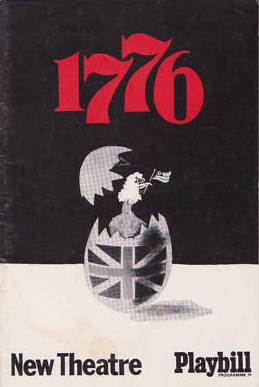
Version 2
1776 (1970-06-Noel Coward Theatre-London)
Type de série: Original LondonThéâtre: Noel Coward Theatre (Londres - Angleterre) Durée : Nombre : 168 représentationsPremière Preview : Inconnu
Première: 16 June 1970
Dernière: InconnuMise en scène : Peter Hunt • Chorégraphie : Onna White • Producteur : Star(s) :
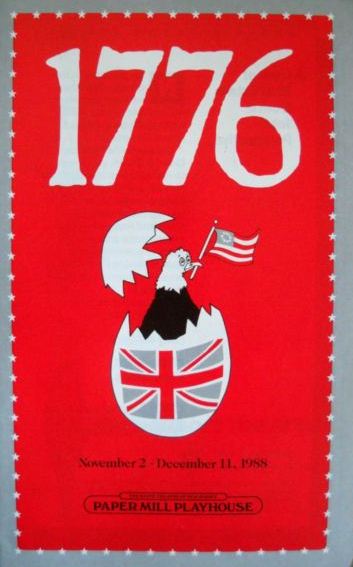
Version 4
1776 (1988-11-Paper Mill Playhouse-Milburn)
Type de série: RevivalThéâtre: Paper Mill Playhouse (Milburn - Etats-Unis) Durée : 1 mois 1 semaine Nombre : Première Preview : Inconnu
Première: 02 November 1988
Dernière: 11 December 1988Mise en scène : Robert Johanson • Chorégraphie : Robert Johanson • Producteur : Star(s) :
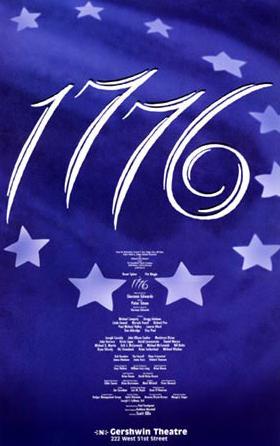
Version 5
1776 (1997-07-Criterion Center Stage Right-Broadway)
Type de série: RevivalThéâtre: Criterion Center Stage Right (Broadway (Off) - Etats-Unis) Durée : Nombre : 34 previews - 333 représentationsPremière Preview : 16 July 1997
Première: 14 August 1997
Dernière: 14 June 1998Mise en scène : Scott Ellis • Chorégraphie : Kathleen Marshall • Producteur : Star(s) : Commentaires longs: Joué au Criterion Center Stage Right (14/8/1997 - 16/11/1997) puis au
George Gershwin Theatre (3/12/1997 - 14/6/1998)

Version 7
1776 (2004-04-Landis Performing Arts Center-Los Angeles)
Type de série: RevivalThéâtre: Landis Performing Arts Center (Los Angeles - Etats-Unis) Durée : 2 semaines Nombre : 9 représentationsPremière Preview : 02 April 2004
Première: 02 April 2004
Dernière: 18 April 2004Mise en scène : Nick DeGruccio • Chorégraphie : ???? ???? • Producteur : Star(s) :
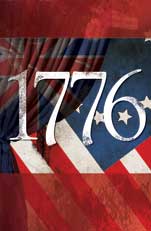
Version 8
1776 (2009-04-Paper Mill Playhouse-Milburn)
Type de série: RevivalThéâtre: Paper Mill Playhouse (Milburn - Etats-Unis) Durée : 1 mois Nombre : Première Preview : Inconnu
Première: 15 April 2009
Dernière: 17 May 2009Mise en scène : Gordon Greenberg • Chorégraphie : Josh Rhodes • Producteur : Star(s) :

Version 9
1776 (2010-06-Plays-in-the-Park-Edison)
Type de série: RevivalThéâtre: Plays-in-the-Park (Edison - Etats-Unis) Durée : 1 semaine Nombre : 10 previews - 25 représentationsPremière Preview : 23 June 2010
Première: 23 June 2010
Dernière: 03 July 2010Mise en scène : Gary P. Cohen • Chorégraphie : Producteur : Star(s) :
Pas encore de video disponible pour ce spectacle
